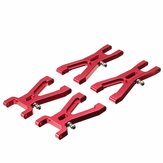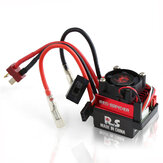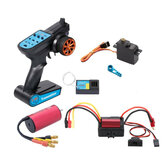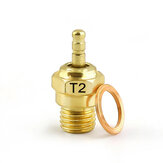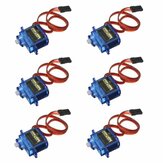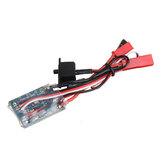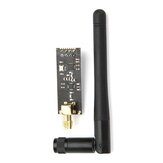20A Double Sides Brushed ESC For RC Car/Boat
Customer Reviews
- All Reviews (278)
- Image (24)
- Video (0)
A part of the review has been auto-translated.
-
01/12/2014
Apparently these were sold as shown in the pictures, before, but now have a small switch soldered to the three pads you can see in the picture of the side of the PCB with the four large FETs on it (and not much else). The switch lets you choose whether or not it has a brake function, which stops the motor quickly if you move the stick from forwards to reverse. To go into reverse, you need to put it into the neutral position first. It only works that way around - moving from reverse to forwards happens instantly, with no brake effect. The switch is only read when you turn it on - it doesn't change anything until you turn it off and back on again. The centre position for the throttle stick is automatically set when you turn it on, to wherever you have the stick, provided it's in a range of roughly 1/4 to 1/2. That's useful for transmitters that have the small switch to move the sprung centre position back, giving you more forwards travel on the stick than reverse. If you try to start it up with the stick outside that range, it just beeps at you. My preference is normally to not have a brake, and to have instant change over from forwards to reverse, and back again. These ESCs can do that, with the switch turned off. I often want an ESC with reverse but no brake, so the model can switch quickly from forwards to reverse. In a boat, there is no point having a brake - stopping the prop won't normally stop the boat any quicker. If you find yourself heading for a collision, you want to be able to reverse immediately. Also, if you want to practise manouvering a model car in a small space, or parallel parking with one, it feels a lot more natural if it changes from forwards to reverse and back again, immediately. I haven't tested the current capability, and personally, I'd probably only use these in small models, or converted toys, but they should be fine for that sort of use. If they really are capable of 20A, I think you'd need to cut the shrink wrap off and fit a heat sink to the four FETs, to make them survive it. The price is very good. I have some toys with more than one motor, that I want to convert to radio control, so it's good to have a source of small, cheap, ESCs like these.
Comments (2)Show Original -
 ARCVIP3US19/05/2020
ARCVIP3US19/05/2020this is my second 20A Double Sides Brushed ESC that I have purchased from banggood.com. I am extremely happy with its performance so far. As you can see I have this one installed in my six wheel drive Eachines EAT-01. I have also one purchased for my c24. runs off a 2-cell lipo with no problems at all. Smooth power delivery for the size and you get to hook it up to a normal sized receiver. On the six wheel drive I will be installing two on-off switches for four sets of independently ran lights.
Comments (2)Show Original -
20/01/2020
Awesome little ESC for the money. Mine came with a tiny switch on the ESC that I don't know what it does but I noticed when driving forward and you got to reverse the brake engages but when your reversing and go to forward the brake doesn't activate and you just jolt forward other then that this is awesome and I will be buying more for future rc builds.
Comments (1)Show Original -
07/12/2018
But what is the switch on the circuit board for? Using it with FS-GT3C, works perfect!!
Comments (1)Show Original -
03/07/2019
great how small it is in size. very smooth regulation of the motor. I would buy it again.
CommentsShow Original -
09/05/2016
This esc is great ideal for 1/24 rc cars, brake works perfect and strong enough for 1/24 scale, nice silicone wires and sturdy on/off switch would buy again!
CommentsShow Original -
 Firo11VIP5SK06/08/2019
Firo11VIP5SK06/08/2019ESC with double-sided sidewalls for RC car / boat. Good!
CommentsShow Original -
17/10/2018
Bardzo małe i fajne ESC. ja używam ich jako sterowania do wyciagarek zrobionych z serw. Wysokie 20A zapewnia moc wyciągarkce. Polecam
CommentsShow Original -
05/01/2020
No description. But the quality is good. Real 20A holds
CommentsShow Original -
 JohntyVIP3SE15/08/2019
JohntyVIP3SE15/08/2019Good Brushed 20 Amp ESC for car/boat with little switch for brake on/off.
CommentsShow Original
































